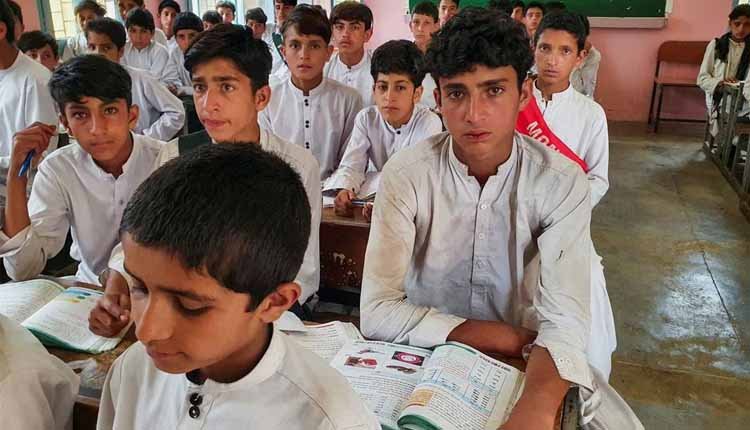Stranded cable car highlights school accessibility crisis in Pakistan
BATTAGRAM: Ibrar Ahmed is relieved to be alive after being stuck on a cable car high over a river in northern Pakistan for 16 hours this week, but now the student wonders how he will make the arduous trek to class each day.
“God willing, I am going to continue with my studies, but the way to our school is so long,” he said after Tuesday’s ordeal, which grabbed global attention.
“Sometimes … I get late for school because it opens at 8:30 a.m. and the road is so perilous,” said Ahmed, in his first year of high school at Batungi Pashto Government School. “The (chair) lift is necessary, but now we are terrified of it.”
Seven children and one man were rescued by Pakistan’s military and civilians from the flimsy cable car after a cable broke, dangling them 183 metres (600 feet) high in mountainous Battagram district north of Islamabad.
The harrowing ordeal highlights a crisis of school accessibility for many in Pakistan, with few high schools, poor roads, poverty and extreme weather hampering students’ ability to get to class.
That is a major reason Pakistan has the world’s second-lowest rate of school attendance. Some 23 million, or 44%, of Pakistani children aged four to 16 are out of school and the situation is worse for girls, according to government figures and the World Bank.
Given Pakistan’s huge youth population, boosting education rates is vital for economic sustainability and to mitigate the security concerns that plague the South Asian country, exacerbated by the lure of militant groups in impoverished rural areas, analysts and economists say.
“Long distances and travel times, few transportation options and costs are some of the barriers to access education, particularly for girls who are often not allowed to travel long distances alone,” said Ellen Van Kalmthout, chief of education at UNICEF Pakistan.
Ahmed wants “a proper road” and a high school near his village.
‘NUMEROUS ACCIDENTS’
Batungi Pashto High School head teacher Ali Asghar Khan links long commutes to high dropout rates.
“Most boys who come from far-off villages try their best to continue but they often face problems in travelling back and forth, either because they are too young or not strong enough or sick, so they definitely leave their studies,” Khan said. “The ratio of dropouts is high here.”
Many students must walk one to three hours each way on poorly built trails, crossing streams that swell into dangerous rivers in rainy seasons, Khan said. Those who make it are often exhausted by the journey, worsened by northern Pakistan’s hot summers and freezing winters. Tired and hungry, they struggle to concentrate, he said.
Communities have strung up scores of cable car systems through the mountainous Khyber Pakhtunkhwa province of steep hills plunging into valleys. They often cut commutes to 20 minutes for a cheap fare but come at a dangerous cost, even before Tuesday’s scare.
“Numerous accidents have occurred in the past,” said former provincial police inspector general Naeem Khan. “Mostly the local people themselves with some help from the local police rescue the stranded people.”
A civilian involved in Tuesday’s rescue said he had rescued people at least six times before on smaller chairlifts.
Some 50 chairlifts dot the hillsides of nearby Swat Valley. Residents said the cars provide a lifeline for students, especially after severe flooding last year damaged infrastructure, but there had been multiple deaths and injuries in the past year.
“Two months ago, a woman and her child fell into the River Swat… when the rope of the cable car broke. Their bodies are yet to be recovered,” said resident Nasrullah Khan.
‘THIS IS OUR DEMAND’
Local officials and development agencies are struggling to fix the problems in the province, which are echoed throughout Pakistan.
“It is very difficult for them to reach schools in far-flung areas, but our government has in the last few years invested heavily and innovative ideas have been brought forward,” said Syed Hammad Haider, additional deputy commissioner of Battagram district.
The World Bank is investing $300 million in rural infrastructure for the province in a project through 2027, with access to education in mind.
Challenges include the shortage of middle and high schools, especially for girls, and the lack of good all-weather roads, “which are becoming increasingly vulnerable to natural disasters due to climate change”, a World Bank spokesperson said.
For students in areas like Battagram who risk their lives to go to school, that cannot come fast enough.
“We will now not go by lift, but I don’t want to leave school either,” said Rizwan Ullah, another rescued student. “We want roads in our region, we want a bridge, we want high schools, we want all these facilities. This is our demand.”


Comments are closed, but trackbacks and pingbacks are open.